HOWARD ALTMAN
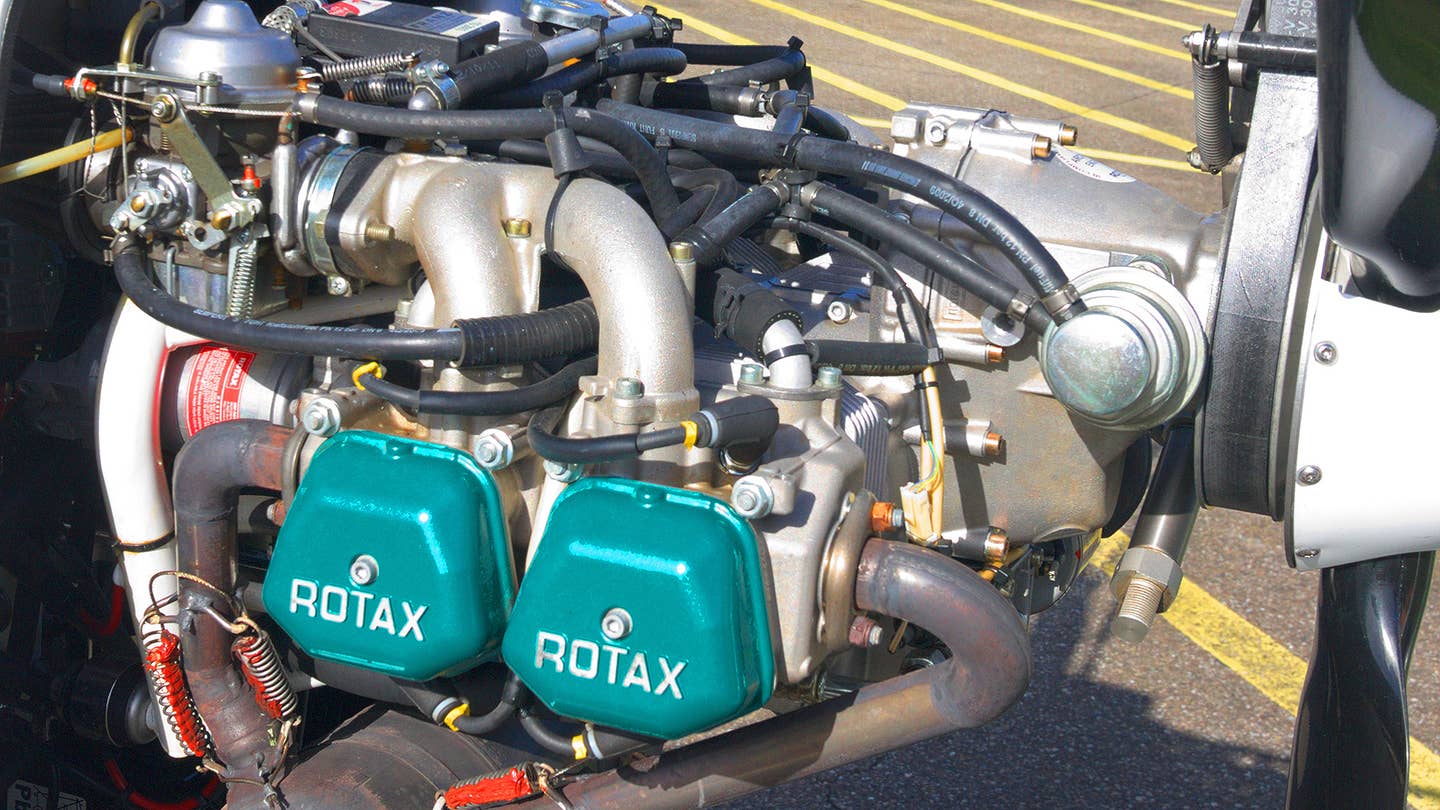 T
TThe Austrian-made Rotax light aircraft engine recently found in a Russian-operated, Iranian-made Mohajar-6 drone recovered by Ukrainian forces is a model that has been at the center of a puzzling and prolonged theft campaign around the globe, but especially in Europe. Sophisticated criminals who know how to circumvent airport security measures and find engines that often have low operating hours and surgically remove them have been the hallmark of the widespread thefts.
So many have been stolen just in the U.K. alone that Operation Opal - a national intelligence team focused on organized crime - was called in to investigate the matter, according to the British Microlight Aircraft Association (BMAA), which along with the Light Aircraft Association (LAA) is collating information about the thefts in the U.K. These facts certainly point to the possibility that Tehran has been getting at least some of its drone engines by having operatives systemically literally rip them out of aircraft in foreign countries.
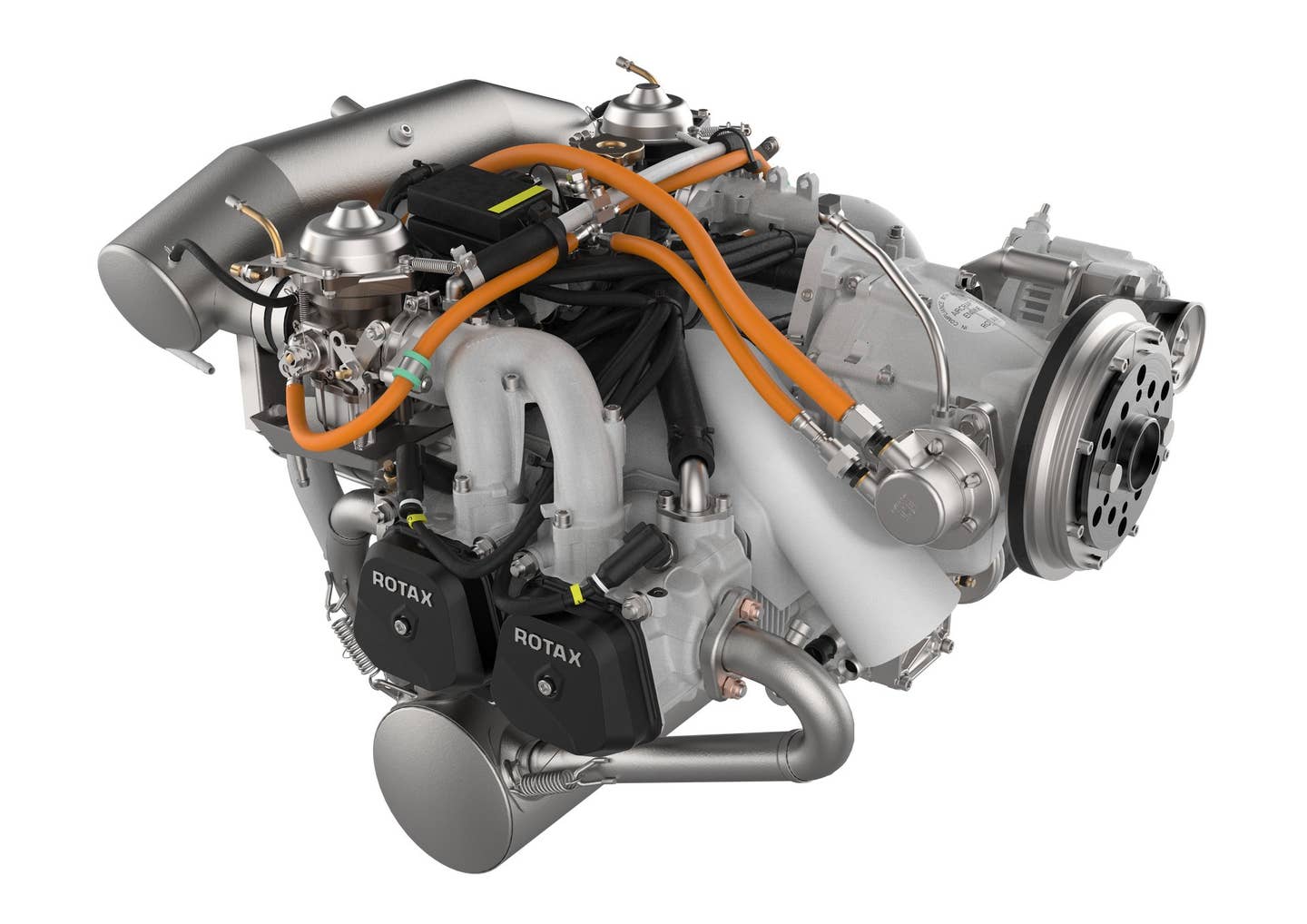 The Rotax 912 aircraft engine. Credit: Rotax
The Rotax 912 aircraft engine. Credit: RotaxInvestigators in Norway are also looking into what is being considered sophisticated thefts of Rotax 912 engines.
Ukrainian authorities recently discovered a Rotax 912 four-stroke piston engine in an Iranian Mohajer-6 medium-altitude, long-endurance (MALE) unmanned aerial vehicle downed over the Black Sea earlier this month. You can read much more about that here.
The aircraft-specific engines made by Rotax, a subsidiary owned by Canadian company Bombardier Recreational Products (BRP), are usually found in light and ultralight aircraft. Their delivery to Iran, however, violates European Union sanctions banning the export of items with both civilian and military purposes, such as vehicle parts. Identical sanctions are imposed by the European Union against Russia, as well.
The discovery of the Rotax engine in the Mohajer-6 brought down over the Black Sea was initially made after Ukrainian intelligence specialists displayed the partially disassembled drone during a CNN network broadcast aired last Tuesday. In it, the outlet’s chief international correspondent Clarissa Ward was given exclusive access to view the recovered and now somewhat dissected drone.
After the discovery of the Rotax engine in the Mohajer-6 drone, Rotax and BRP issued a media release denying any wrongdoing.
“We have been made aware of the alleged use of Rotax engines, or counterfeit engines, in certain specific situations involving Iranian Mohajer-6 drones in the conflict areas,” read the press release. “We are taking this situation very seriously. BRP has not authorized and has not given any authorization to its distributors to supply military UAV manufacturers in Iran or Russia.”
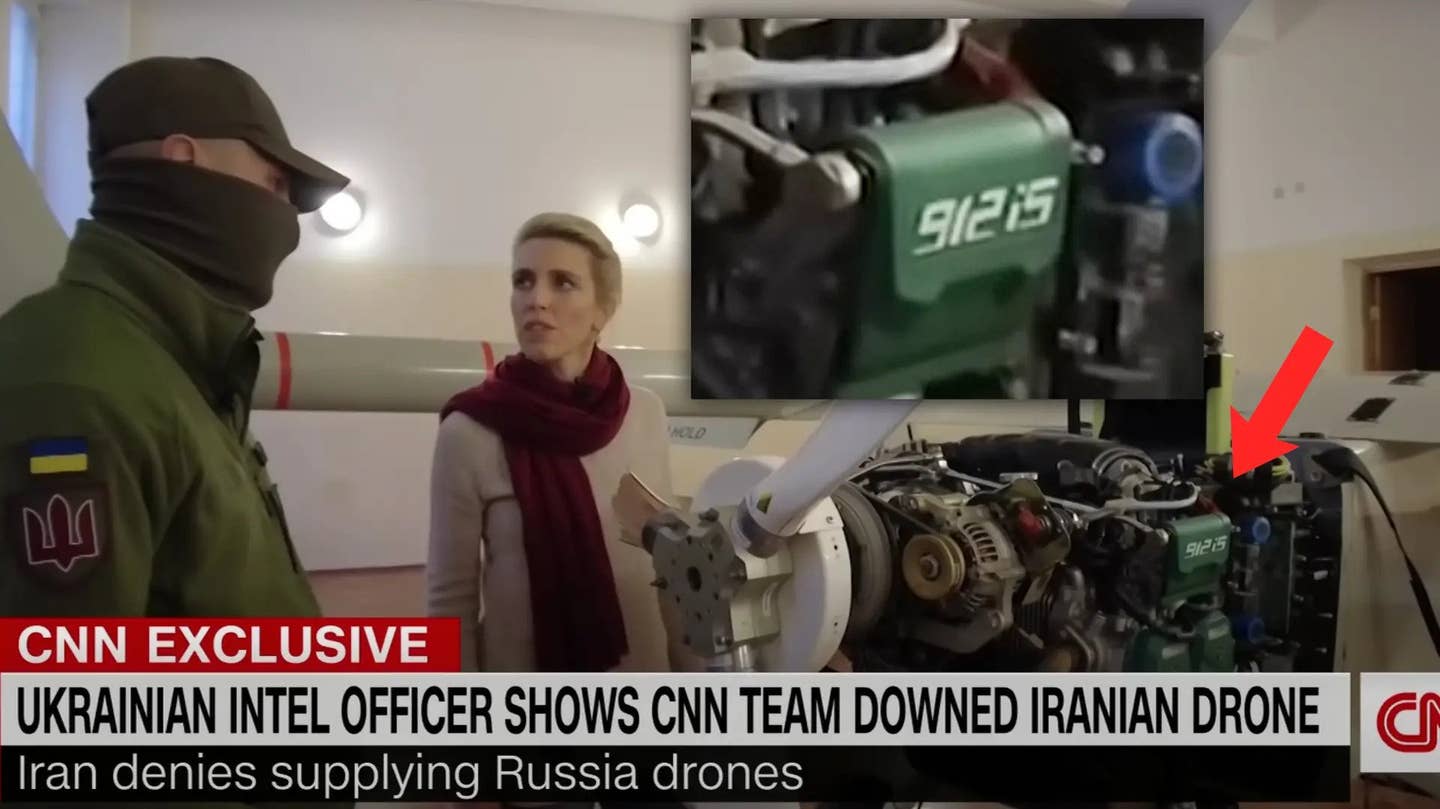 A view of the Rotax 912iS engine found in the Iranian drone. Credit: CNN Screencap
A view of the Rotax 912iS engine found in the Iranian drone. Credit: CNN ScreencapIn years past, other Russian drones have featured Rotax engines, which have been used to power General Atomics' MQ-1 Predator and Israel's Heron drones as well.
Reports of Rotax engines powering Iranian UAVs have existed for some time, specifically the Rotax 912 and 914 light aircraft engine variants. For example, the Iranian-made Shahed-129 is widely reported to use a Rotax 914 four-cylinder engine and first entered serial production in 2013.
We reached out to Rotax Monday and Tuesday and will update this story should it provide a response.
According to the company website, more than 130 Rotax 912 engines and six Rotax 914 engines have been stolen worldwide between 2000 and 2021. The first was stolen in Germany and the most recent in Florida.
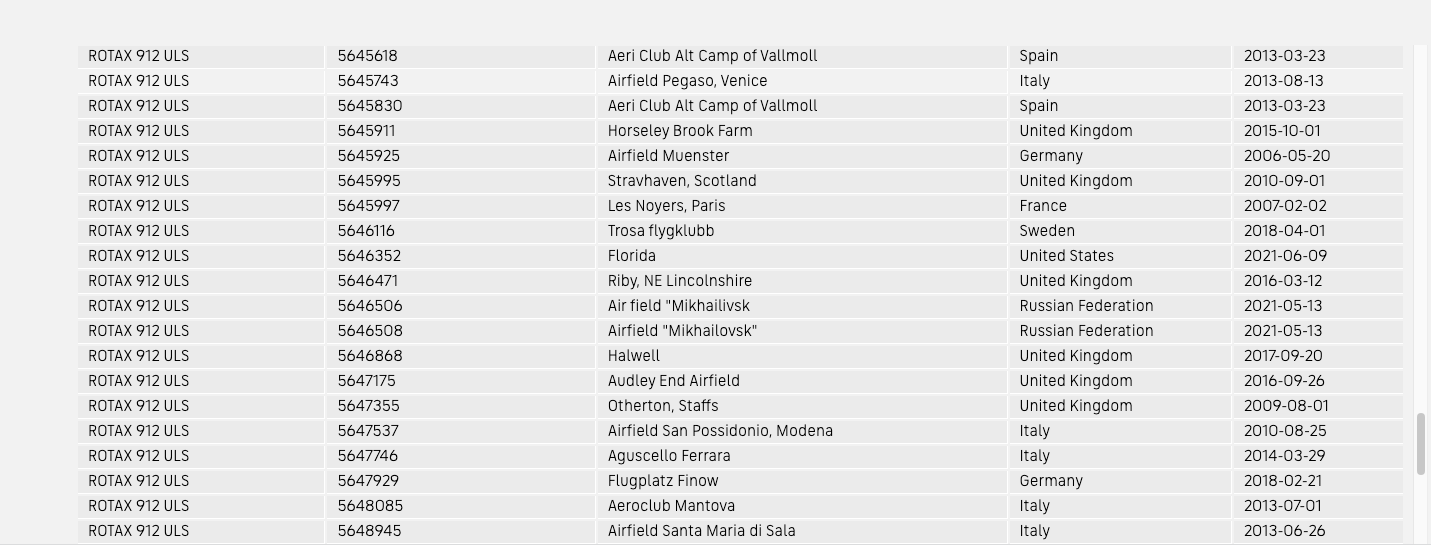 Rotax has a list of more than 130 912 and 914 engines that were stolen between 2000 and 2021, here is just a snippet from it. (Rotax screen cap)
Rotax has a list of more than 130 912 and 914 engines that were stolen between 2000 and 2021, here is just a snippet from it. (Rotax screen cap)The U.K., which had 36 such thefts, topped the list, followed by Germany with 31. There were seven stolen from the U.S. and four from Russia.
The thefts peaked in 2016, with 18, and by 2021, tailed off, with only five reported on the Rotax website.
“The theft of Rotax engines from aircraft and airfields around the UK shows no sign of abating,” Flyer, an aviation enthusiast publication, reported in October 2016 in an article pointing to the sophistication of the thefts. “The thieves clearly targeted the aircraft and avoided CCTV cameras at the airfield by breaking into the rear of the hangar.”
The thefts “follow a similar scenario to those reported in Northamptonshire and Cambridgeshire earlier this year, LAA reported on its Facebook page in August 2016. “In this case, three aircraft were targeted, two gyroplanes and a Skyranger.”
Each of those aircraft “had relatively low-hours Rotax 912 engines, which were removed, but the pusher propellers from the gyros were left behind. It is noteworthy too, that two similar aircraft on the strip with high hours 912 engines were left untouched. As with the previous thefts, it was clearly a planned raid, with the thieves accessing the airfield across country and removing the engines with care.”
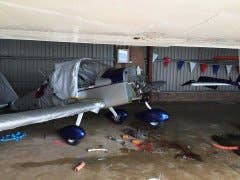
An aircraft that had its Rotor 912 engine stolen. (Twitter photo)
LAA urged its members to “be on the lookout for ‘too good to be true’ bargain offerings, and please also exercise due vigilance if you fly from a private strip, perhaps reinforcing any security,” according to the Facebook post. “We’re liaising with the local Police to share our knowledge of the earlier incidents. If you have any information which might help apprehend these villains, please contact LAA HQ.”
World microlight champion David Broom, who runs Airplay Aviation, became a Rotax engine theft victim in 2017 and suspected "a fairly professional operation" was behind it, according to Flyer.
“They obviously knew exactly what they wanted, where to cut and what bits were important, so it was a fairly professional operation," Broom told Flyer. "The office cabin, workshop and two hangars were all broken into and damaged."
We contacted local police in the U.K. as well as Operation Opal and will update this story with any information they provide.
U.K. authorities aren’t the only ones looking into sophisticated Rotax 912 engine thefts.
Norwegian authorities are also looking into thefts there by criminals who apparently knew exactly what they were doing and were organized enough to be able to carry away an engine weighing more than 220 pounds undetected.
“Nothing was damaged and the aircraft engine was picked neatly from the aircraft,” according to an Oct. 31, 2021 story by Norway’s TV2 news. “A blanket had been laid over it and a bucket of oil and screws lay underneath.”
“There are obviously professional thieves who have been here,” Pål Vindfallet, deputy head of the Innlandet flight club and flight school, told the station. “They have taken the trouble to disassemble every little part and have not used off-cuts for anything.”
Several other aircraft engines were stolen in Norway, according to TV2 and officials are investigating to see if there is a connection.
Thomas Hauklien, the only Rotax supplier in Norway, told TV2 he is “certain that there is a connection between the thefts.”
Considering how professionally the thefts were carried out, Hauklien told TV2 he suspects that the thefts were "made to order."
And given the reports in Norway, the thefts listed in the Rotax database are likely only a fraction of the real number.
That database, for instance, only lists two thefts from Norway, both in 2018 and neither from the clubs cited by TV2 that took place in 2021.
Rotax engine thefts have raised such a concern in the aviation community that one pilot said he installed a tracking device in the engine on his aircraft, something you can watch him talk about in this video below.
Overall, Rotax engines are quite common, especially in light and experimental general aviation aircraft, and they clearly end up on the secondary market and there is potentially a black market for even newer examples. Iran is also well known to have entire networks dedicated to circumventing sanctions and acquiring various military and dual-use tech, as does Russia and especially North Korea. Everything from fake cutout companies to just straight-up theft could account for some engines, and that is on top of the secondary marketplace.
While there are likely many vectors for Iran to get its hands on Rotax engines, executives from a U.S. drone company that does business with the government told The War Zone on Tuesday that it would not be surprising to hear Iran obtained drones from a criminal enterprise.
There is precedence for criminal activity being tied to Iranian drone engine acquisition.
In 2014, for example, two Iranian men were charged with smuggling dozens of German-made engines capable of powering drones into Iran. They went on trial in Frankfort, according to Reuters.
One was accused of obtaining 61 engines between 2008 and 2009 and delivering them to Iran through his own import-export company. To get through customs, he allegedly declared them as jet ski engines.
And last year, the U.S. Treasury Department sanctioned a number of Iranian companies associated with drone production.
“Iran’s proliferation of UAVs across the region threatens international peace and stability. Iran and its proxy militants have used UAVs to attack U.S. forces, our partners, and international shipping,” said Deputy Secretary of the Treasury Wally Adeyemo in a media release at the time. “Treasury will continue to hold Iran accountable for its irresponsible and violent acts.”
Questions about Iranian drones are not the first that Rotax has faced about its products.
In 2020, Rotax-BRP came under fire after it was learned that their engines were powering the Turkish Bayraktar TB2 drones used to target Armenians during the Nagorno-Karabakh conflict. As a response to the situation, BRP announced it would be temporarily suspending the export of Rotax 912 engines to “countries with unclear usage.”
And earlier this month, a Rotax 912 was found to be powering another Mohajer-6 drone that had been shot down by KDPI Peshmerga forces in Iraq.
As noted in our previous report, there are likely a variety of ways Iran gets its hands on Rotax and other export-controlled engines for its unmanned aircraft, including possibly using front companies, smuggling, the second-hand market, and theft. The fact that there has been a sustained wave of bizarre and well-orchestrated thefts of the exact type of engines that power their key unmanned aircraft systems certainly points to at least a thriving black market for these engines if not a straight-up Iranian operation to obtain them via outright theft. It also isn't clear how far Iranian's own industry has come with being able to clone the engines and to what degree of quality, but clearly, that would be a top priority.
At the moment, it is unknown how the Rotax engine in question wound up in the Iranian Mohajer-6 drone that Kyiv is displaying. But we will keep an eye on this situation and report any additional information we uncover.
No comments:
Post a Comment